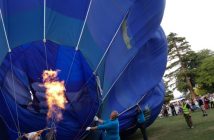The number one question we are asked every day is “how is the Waikato tourism sector going?”.
Overall, the Waikato region is not as significantly impacted as other areas experiencing closure or hibernation of tourism businesses and job losses across the sector. We stand in solidarity with our fellow tourism regions and appreciate the efforts of New Zealanders to ‘Do Something New, New Zealand’ by travelling the length and breadth of Aotearoa.
Although the Waikato is experiencing a decline in overall visitor expenditure, our strong domestic destination proposition, summer calendar of events and the solid return of conferences, meetings and exhibitions, has helped us buffer the impacts.
We are also fortunate enough to have over 2.65 million people living within three hours’ drive of Hamilton and Waikato, making us an attractive short-break destination. Before Covid-19, 75 percent of our visitor market was domestic – event goers, conference attendees, friends and family, alongside leisure and business travellers.
With such a geographically diverse region, our rebound as a tourism sector varies across Waikato. Hamilton is currently experiencing the fastest turnaround with strong growth across accommodation, hospitality and retail with increased visitor numbers. However, the communities of Matamata and Waitomo are suffering without the presence of international travellers.
It has been estimated that 42 percent of New Zealand’s visitor economy comes from international tourism and there is an expected gap of $12.9 billion in visitor expenditure. Domestic travellers spend on average $155 per day and, when they return, international visitors spend on average $232 per day, which is over three-times more than local residents at $74 per day. Tourism remains vital to the region’s post-Covid recovery with every $178,000 of tourism spend, which equates to 40 international visitors or 480 domestic overnight trips, creating a job.
To help the region’s visitor economy restart and rebound, we have worked harder than ever to build demand and attract additional domestic visitors to the region. For the first-time, we’ve marketed the region throughout the Christmas/New Year period to encourage New Zealanders to visit our magical region, efforts normally reserved for the shoulder seasons due to being busy with international travellers over summer. From our partnership with Tourism New Zealand’s ‘Do Something New, NZ’ campaign, through to our own ‘It’s Just Magic’ video-led digital campaign, we are excited about the results being delivered.
We have been proud of the results from our work in the media/PR and content partnership space as well, with our regional feature in this January’s Cuisine magazine and the December issue of NZ House and Garden. We have been gaining a lot of media coverage across the Stuff Travel network, NZ Herald Travel and Newshub. This includes digital, radio and metro airports advertising as well as a second edition of the ‘Never Have I Ever’ Neat Places city guides. We have a number of locals sharing their insider tips to places to eat, drink and explore in Hamilton city.
We know that hosting major and business events are crucial to lead the economic and social recovery of the Waikato region. National research indicates that up to one-third of domestic travel is primarily driven by people looking to participate in events. Based on this, we launched our Summer Events campaign which utilises digital marketing in our main drive markets, supported by a printed 2021 Waikato Summer Events Guide which was an insert in key daily and community newspapers in the Central North Island. The Waikato has a jam-packed events calendar to encourage locals and the domestic traveller to visit our region. The new $3.75m Regional Events Fund is now open for expressions of interest. This fund will be spread over 3-4 years and collectively covers the regions of Waikato, Rotorua, Taupō and Ruapehu. The fund will help activate our Major Events Strategy, which was completed two years ago to help drive domestic visitation and grow our existing event portfolio.
As a non-ski destination, we know we will have to work harder to build demand and attract the domestic market during winter. We are excited with the return of Fieldays in June 2021 which will provide the region with a much-needed economic injection during our traditionally quieter months.
In closing, I want to acknowledge the outstanding contribution and sacrifice for all the hotel staff who are working at our three Managed Isolation Facilities. These people have sacrificed so much and are working on the frontline to help protect New Zealanders. It has been disappointing to hear some stories of the stigma and poor treatment they have received from members of our community. They are part of our tourism whānau and need to be supported, cared for, thanked and welcomed by all of us.





